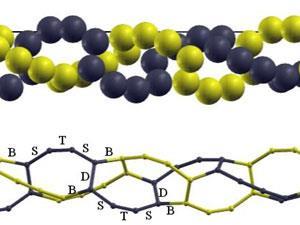
This ultrathin carbon nanotube, actually somewhere between a tube and a wire, has been predicted by computational chemists at the Autonomous University of Madrid, Spain, to be stable up to 1000K.
Carbon nanotubes thinner than 3Å in diameter are generally believed to be unstable, because of the large bond distortion required for them to maintain their shape. But Jose Manuel Garcia de la Vega's team have calculated that their carbon double helix, with an outer diameter of around 3.2Å and made of alternating single (S), double (D) and triple (T) carbons should exist, and have predicted the Raman, infrared and optical absorption spectra of the material.






No comments yet